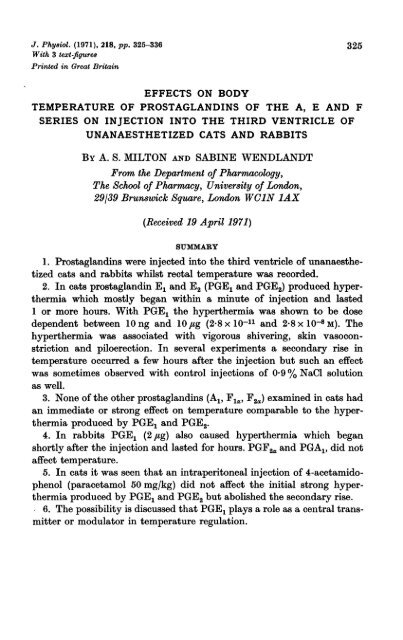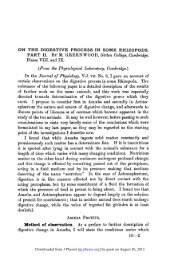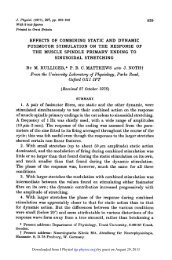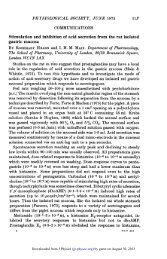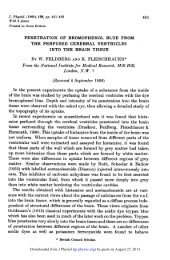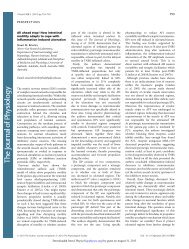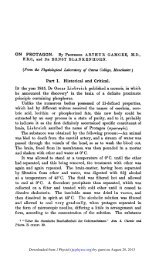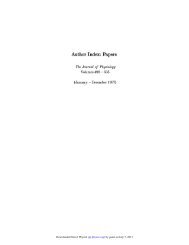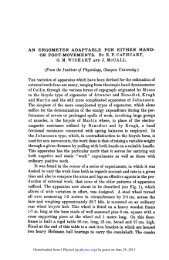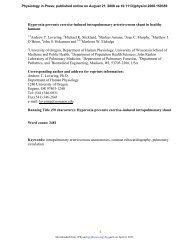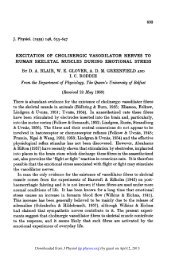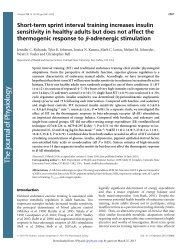MILTON AND SABINE WENDLANDT
MILTON AND SABINE WENDLANDT
MILTON AND SABINE WENDLANDT
Create successful ePaper yourself
Turn your PDF publications into a flip-book with our unique Google optimized e-Paper software.
J. Physiol. (1971), 218, pp. 325-336 325<br />
With 3 text-ftgurem<br />
Printed in Great Britain<br />
EFFECTS ON BODY<br />
TEMPERATURE OF PROSTAGL<strong>AND</strong>INS OF THE A, E <strong>AND</strong> F<br />
SERIES ON INJECTION INTO THE THIRD VENTRICLE OF<br />
UNANAESTHETIZED CATS <strong>AND</strong> RABBITS<br />
BY A. S. <strong>MILTON</strong> <strong>AND</strong> <strong>SABINE</strong> WENDL<strong>AND</strong>T<br />
From the Department of Pharmacology,<br />
The School of Pharmacy, University of London,<br />
29/39 Brunswick Square, London WC1N lAX<br />
(Received 19 April 1971)<br />
SUAMMVARY<br />
1. Prostaglandins were injected into the third ventricle of unanaesthetized<br />
cats and rabbits whilst rectal temperature was recorded.<br />
2. In cats prostaglandin E1 and E2 (PGE1 and PGE2) produced hyperthermia<br />
which mostly began within a minute of injection and lasted<br />
1 or more hours. With PGE1 the hyperthermia was shown to be dose<br />
dependent between 10 ng and 10 ,tg (2.8 x 10-11 and 2.8 x 10- M). The<br />
hyperthermia was associated with vigorous shivering, skin vasoconstriction<br />
and piloerection. In several experiments a secondary rise in<br />
temperature occurred a few hours after the injection but such an effect<br />
was sometimes observed with control injections of 0-9 % NaCl solution<br />
as well.<br />
3. None of the other prostaglandins (A1, F1,, F2X) examined in cats had<br />
an immediate or strong effect on temperature comparable to the hyperthermia<br />
produced by PGE1 and PGE2.<br />
4. In rabbits PGE1 (2fg) also caused hyperthermia which began<br />
shortly after the injection and lasted for hours. PGF2a and PGA1, did not<br />
affect temperature.<br />
5. In cats it was seen that an intraperitoneal injection of 4-acetamidophenol<br />
(paracetamol 50 mg/kg) did not affect the initial strong hyperthermia<br />
produced by PGE1 and PGE2 but abolished the secondary rise.<br />
6. The possibility is discussed that PGE1 plays a role as a central transmitter<br />
or modulator in temperature regulation.
326<br />
A. S. <strong>MILTON</strong> <strong>AND</strong> S. WENDL<strong>AND</strong>T<br />
INTRODUCTION<br />
The results of the present experiments show that the prostaglandin<br />
E1 (PGE1) and E2 (PGE2) exert a strong hyperthermic effect when injected<br />
in minute amounts into the third cerebral ventricle of the<br />
unanaesthetized cat and rabbit.<br />
Prostaglandins have been shown to be natural constituents of the central<br />
nervous system of various species including cats and rabbits (Samuelsson,<br />
1964; Coceani & Wolfe, 1965; Ambache, Brummer, Rose & Whiting,<br />
1966; Horton & Main, 1967a). The distribution of the E and F series of<br />
prostaglandins has been investigated in the central nervous system of the<br />
dog by Holmes & Horton (1968 a), who found them not only in the cerebral<br />
cortex, cerebrum and spinal cord, but also in those parts of the brain which<br />
line the cerebral ventricles such as the hippocampus, caudate nucleus and<br />
hypothalamus. They appear to be released from these structures into the<br />
perfused cerebral ventricular system as shown in anaesthetized cats<br />
(Feldberg & Myers, 1966) and dogs (Holmes, 1970). According to Holmes<br />
the concentration of the E series of prostaglandins increases fourfold on<br />
perfusion with 5-hydroxytryptamine. Prostaglandins were also detected<br />
in superfusate from the cerebral and cerebellar cortex (Ramwell & Shaw,<br />
1966; Wolfe, Coceani & Pace-Asciak, 1967).<br />
No definite physiological function has so far been attributed to the<br />
prostaglandins in the central nervous system but they have been shown<br />
to modulate nerve cell activity (Avanzino, Bradley & Wolstencroft, 1966;<br />
Hoffer, Siggins & Bloom, 1969; Kaplan, Grega & Buckley, 1968; Duda,<br />
Horton & McPherson, 1968; Phillis & Tebecis, 1968) and to alter animal<br />
behaviour, to produce signs of sedation, stupor and catatonia in cats, to<br />
antagonize electrical and leptazol induced convulsions in rats and to<br />
affect muscle tone and reflex activity in various species (for references see<br />
Horton, 1968). The results of the present experiments suggest that PGE1<br />
and PGE2 by their hyperthermic actions may play a role in temperature<br />
regulation and that this may be one of their physiological functions in the<br />
hypothalamus.<br />
METHODS<br />
Cats and Dutch rabbits of either sex weighing between 2-5 and 3-5 kg were used.<br />
Cannulation of third ventricle. The cats were anaesthetized with pentobarbitone<br />
sodium (40 mg/kg i.P.). The head of the cat was held in a stereotaxic apparatus, the<br />
eardrums being protected by rubber caps fitted onto the earbars. Under aseptic<br />
conditions, a hole 1-5 mm in diameter was drilled through the bone in the midline<br />
and 12-5 mm anterior to the interaural line. A stainless-steel guide cannula (20-gauge<br />
needle tubing) with a rubber-capped cannula head was lowered through the hole in<br />
the skull to 6 mm above the interaural line. This placed the guide cannula in the
PROSTAGL<strong>AND</strong>INS <strong>AND</strong> BODY TEMPERATURE 327<br />
third ventricle at the level of the anterior hypothalamus. The co-ordinates were<br />
taken from the stereotaxic atlas of the cat brain by Snider & Niemer (1961).<br />
The rabbits were anaesthetized with paraldehyde (1-5 ml./kg i.P.) and a rubbercapped<br />
cannula similar to that used in the cat was implanted into the third<br />
ventricle 7-5 mm posterior to the coronal suture and to a depth of 13-5 mm from the<br />
surface of the skull.<br />
Correct implantation of the cannula in both cat and rabbit was apparent by the<br />
pulsatile flow of c.s.f. from a needle inserted into the rubber cap of the cannula.<br />
Once flow was established the cannula was fixed to the bone with acrylic cement<br />
anchored by two stainless-steel screws screwed into the skull. Benzyl-penicillin<br />
powder was sprinkled on to the wound and 2000 units were injected intramuscularly<br />
daily for 3 days. The cannula and cannula holder were heat sterilized and flushed<br />
with pyrogen-free saline before implantation. The animals were allowed to recover<br />
for at least a week before being used for experiments.<br />
Temperature measurement. The experiments were performed at an ambient temperature<br />
of 20-22° C unless otherwise stated. The cats moved about freely in the<br />
cage while the rabbits were restrained in a rabbit holder. Temperature was<br />
measured with a thermistor probe (Yellow Springs 400) inserted about 8 cm into<br />
the rectum and held in position with adhesive tape. Temperature was monitored<br />
continuously by a Honeywell multi-channel chart recorder. The temperature responses<br />
were plotted on graph paper with time (1 cm = 1 hr) as abscissa, and temperature<br />
change (2 cm = 10 C) as ordinate. The number of cm2 between the curve<br />
and the base line was counted and divided by two, to give a thermal response index<br />
(TRI). Each unit of TRI is equivalent therefore to a 1° C change lasting for 1 hr.<br />
Administration of drugs. Solutions were injected into the third ventricle via a<br />
polyethylene tube attached to a cannula made of 27-gauge stainless-steel needle<br />
tubing. Both tube and cannula were filled with the solution and the cannula was<br />
passed through the rubber diaphragm of the previously implanted guide cannula.<br />
A flange around the inner cannula prevented it from extending more than 1-0 mm<br />
beyond the tip of the outer guide cannula. A control injection of 5 ,I. pyrogen-free<br />
0-9 % NaCl solution was given 1-2 hr before each prostaglandin injection. The<br />
prostaglandins were injected in a volume of 5 or 10 Al. Immediately after the injection<br />
the cannula was flushed with 5 Id. sterile 0 9 % NaCl solution.<br />
In several experiments in which the effect of Paracetamol (4-acetamidophenol;<br />
4-Ac) on the hyperthermia produced by PGE1 and PGE2 was examined it was<br />
injected I.P. in a dose of 50 mg/kg. The 4-Ac was dissolved in 2-0 ml of hot 0-9 % NaCl<br />
solution containing 20 % propylene glycol and, before injection, made up with<br />
0 9 % NaCl solution to 4 ml. A similar volume of propylene glycol saline containing<br />
no 4-Ac was used for control injections.<br />
Preparation of pyrogen-free prostaglandin solutions. Stock solutions of the prostaglandins<br />
in methanol were stored at - 150 C. A sterile solution suitable for<br />
intraventricular injection was prepared from the stock solution by the following<br />
procedure. The methanol was evaporated using a rotary evaporator with a water bath<br />
temperature of 400 C. The pure prostaglandin residue was dissolved in sterile pyrogen-free<br />
0 9 % NaCl solution and passed through a GS 0-22 ,m 'Millipore' filter before<br />
injection. The 'Millipore' filter was sufficiently fine to remove any particulate matter<br />
including bacteria. The filtered solution was stored at - 150 C until required, and<br />
was thawed and warmed to room temperature before injection. All glassware and<br />
the 'Millipore' filter unit were autoclaved before use.
328<br />
A. S. <strong>MILTON</strong> <strong>AND</strong> S. WENDL<strong>AND</strong>T<br />
RESULTS<br />
Cats<br />
PGE1. As shown in Table 1, the injection, at room temperature (20-<br />
220 C), of PGE1 in doses between 10 ng and 10 ,sg produced a dose dependent<br />
rise in temperature. Temperature began to rise after a latent period<br />
which was independent of the dose and varied between 30 sec and 3 min<br />
(mean of twelve experiments 1 min). On the other hand, the time at which<br />
the maximum rise was attained and the duration of the rise were dose<br />
dependent as shown in columns 6 and 7 of Table 1. The threshold dose<br />
&<br />
+2<br />
E +1<br />
U<br />
C<br />
C<br />
lOng 100 ng 1 0 Ig<br />
0 1 2 3 4 5 0 1 2 3 4 5<br />
Hours Hours<br />
(day 1) (day 5)<br />
Fig. 1. Rectal temperature of the unanaesthetized cat. At the arrows<br />
injections into the third ventricle of PGE1 in the doses as indicated. The<br />
first two injections were made on the same day, the third injection 5 days<br />
later.<br />
was about 10 ng (2-8 x 10-11 M). Fig. 1 illustrates the effect of this dose and<br />
of two larger ones on the same cat. The rise produced by 10 ng was<br />
0. 30 C, by 100 ng 1.10 C and by 1 fig, given 5 days later, 20 C.<br />
The rises were associated with skin vasoconstriction as evidenced by the<br />
coldness of the ears, nose and paws, and by shivering. It was vigorous and<br />
widespread after the larger doses of PGE1. As the temperature reached its<br />
maximum, shivering decreased and finally ceased. With doses of 1 and<br />
10ong piloerection occurred regularly during the vigorous shivering; with<br />
smaller doses piloerection was not regularly observed. After 1 and 10 FuZg<br />
the vigorously shivering cat was usually sitting quietly in the cage with<br />
the head lowered, the eyes closed and the forepaws tucked under the body.<br />
In this condition, some cats responded to touch and external stimuli,
No. of<br />
expts.<br />
3<br />
3<br />
2 3<br />
PROSTAGL<strong>AND</strong>INS <strong>AND</strong> BODY TEMPERATURE 329<br />
others were unresponsive and appeared stuporous, but there were no<br />
definite signs of catatonia. In a few cats defaecation and diarrhoea were<br />
observed. Ear twitching was a frequent occurrence with all doses injected.<br />
Sometimes a secondary rise in temperature occurred. It developed<br />
gradually either before or after the temperature had returned to the preinjection<br />
level, reached its maximum after about 5 hr and lasted up to<br />
11 hr. During this rise, shivering reappeared and the cat sat in the cage<br />
with eyes closed in a manner similar to that observed during a fever produced<br />
by an intraventricular injection of 5-HT or bacterial pyrogen.<br />
A late rise was sometimes observed also with control injections of saline<br />
solution.<br />
TABLE 1. Temperature response (mean values) in the unanaesthetized cat to<br />
intraventricular injection of PGE1. TRI (thermal response index)<br />
Dose of<br />
PGE1<br />
(#g)<br />
0-01<br />
0-10<br />
0-50<br />
1-00<br />
la^ 1%<br />
4-Ac<br />
50 mg/kg<br />
I.P.<br />
1 IUIUU -<br />
1 0-20 Injected 30 min<br />
before PGE1<br />
2 1-00 Injected 90min<br />
before PGE1<br />
1 1-00 Injected 30 min<br />
after PGE1<br />
1 10-00 Injected 30 min<br />
before PGE1<br />
1 10-00 Injected 50 min<br />
after PGE1<br />
2 050 -<br />
Time Dura-<br />
Latency Max. to max. tion of<br />
of temp. temp. temp. temp.<br />
response increase increase response<br />
(min) (0C) (min) (min)<br />
1-2 0.4 17 80<br />
1-3 0-9 38 100<br />
0-5 1-3 50 165<br />
1-0 1-6 50 205<br />
0-5 2-0 55 300<br />
0-5 1.0 55 200<br />
TRI<br />
0-5<br />
1-6<br />
2-2<br />
3-2<br />
5-9<br />
2-0<br />
Ambient<br />
temp.<br />
20-22° C<br />
20-22° C<br />
20-22° C<br />
20-22° C<br />
20-22° C<br />
20-22° C<br />
3-0 1-8 45 180 3.5 20-220 C<br />
0-5 2-8 40 230 5.9 20-220 C<br />
0-5 3-0 40 330 9-0 20-220 C<br />
0-5 2-5 55 270 6-4 20-220 C<br />
2-0 1.1 85 205 2-3 360C<br />
In two experiments, 0-5 ,ug PGE1 was injected while the cats were kept<br />
at an ambient temperature of 360C; they showed the behavioural responses<br />
characteristic of heat dissipation, such as fur licking, lying on the<br />
side with legs outstretched and panting. Nevertheless, the injections produced<br />
a rise in temperature of about the same extent as in the experiments<br />
carried out at room temperature, but the rise developed more<br />
gradually and shivering was much weaker. The results of these two<br />
experiments are included in Table 1 (bottom line).<br />
As shown in Table 1, an I.P. injection of 4-Ac, 50 mg/kg, did not reduce<br />
the immediate hyperthermic effects produced by intraventricular injec-
330 A. S. <strong>MILTON</strong> <strong>AND</strong> S. WENDL<strong>AND</strong>T<br />
tion of 0*2-10 ,tg PGE1 whether this antipyretic drug was given before or<br />
after PGE1. In fact, the hyperthermias induced by PGE1 appeared to be<br />
accentuated. For instance, in the experiment of Fig. 2, 4-Ac was injected<br />
30 min before the intraventricular injection of 10 jug PGE1 which produced<br />
a particularly large rise of 30 C. On the other hand the prolonged<br />
U0<br />
I-<br />
0<br />
41<br />
40<br />
Q. 39<br />
SE<br />
u<br />
'4J<br />
9C)<br />
38<br />
37<br />
0 5<br />
Hours<br />
10<br />
Fig. 2. Temperature record of an unanaesthetized cat. At the first arrow<br />
marked 4-Ac, 50 mg/kg was injected i.P. and at the arrow marked PGE1,<br />
10 #ag PGE1 was injected into the third ventricle (same experiment as given<br />
on third line from bottom in Table 1).<br />
secondary rise observed sometimes after an injection of PGE1 was<br />
abolished by the 4-Ac injection, the temperature began to fall after a<br />
latency of about 15 min and fell even below the level recorded before the<br />
PGE1 injection. Normal temperature was either not affected by an i.P.<br />
injection of 4-Ac, 50 mg/kg, or it fell by not more than half a degree.<br />
The accentuation of the immediate and the abolition of the late hyperthermias<br />
were due to the 4-Ac and not to the solvent because these
PROSTAGL<strong>AND</strong>INS <strong>AND</strong> BODY TEMPERATURE 331<br />
effects were not obtained with control injections of propylene glycol-O9 %<br />
NaCl solution. The aboliton of the late rise resembled the similar effect<br />
previously observed with 4-Ac on the fever produced by intraventricular<br />
injections of 5-HT or bacterial pyrogen (Milton & Wendlandt, 1968).<br />
PGE2. This prostaglandin was injected intraventricularly in doses of<br />
1 and 5 jug only. Both doses raised temperature and produced behavioural<br />
effects similar to those observed with PGE1. The rise in temperature was<br />
of immediate onset and reached a maximum within an hour; temperature<br />
then either returned to the pre-injection level within 3-4 hr, or, after<br />
having begun to fall, rose again and this secondary rise lasted up to 10 hr.<br />
41<br />
UO 40-<br />
I 39<br />
E<br />
X 4-Ac \<br />
, 38 mG t 2 X-<br />
0 4-Ac<br />
_ I<br />
5<br />
~<br />
10<br />
~ ~<br />
15<br />
~ ~~~~~~~~ I I<br />
20<br />
Hours<br />
Fig. 3. Rectal temperature of the unanaesthetized cat. At the first and third<br />
arrow i.P. injections of 4-Ac, 50 mg/kg; at the second arrow intraventricular<br />
injections of 5 ,ug PGE2.<br />
As with PGE1 the initial rise was not abolished or attenuated by 4-Ac<br />
which, however, had an antagonizing effect on the secondary rise. A typical<br />
experiment is illustrated in Fig. 3, which shows that the injection of 5 #ug<br />
PGE2 given 1 hr after an i.p. injection of 50 mg/kg 4-Ac caused a rise of<br />
over 20 C. During the following 4 hr, temperature returned to nearly preinjection<br />
level, but then began to rise again. This secondary rise was suppressed<br />
by another injection of 4-Ac and temperature fell during the<br />
following 5 hr. The occurrence of the secondary rise in spite of the first<br />
4-Ac injection is explained by the fact that the action of 4-Ac lasts for a<br />
few hours only. In the experiment of Fig. 3 the effect of the second 4-Ac<br />
injection also began to wear off after a little over 5 hr. In other experiments<br />
in which the 4-Ac was given after the prostaglandin injection,<br />
during the initial rise, the result was the same. The initial rise continued<br />
while a secondary rise when it occurred was delayed.<br />
PGFO12,. Intraventricular injections of 1 or 1O ,tg of this prostaglandin<br />
produced no immediate effect on temperature in some cats, small rises in
332<br />
A. S. <strong>MILTON</strong> <strong>AND</strong> S. WENDL<strong>AND</strong>T<br />
others and, in a few, rises of nearly 10 C. These rises differed from those<br />
produced by PGE1 and PGE2 in that they were not associated with<br />
shivering and skin vasoconstriction. The injections, however, produced<br />
restlessness and diarrhoea. The effect of an i.P. injection of 4-Ac, 50 mg/kg,<br />
was examined in two cats in which the PGF1. injection had previously<br />
caused a small, immediate, but long-lasting rise. In the one cat in which<br />
the 4-Ac was injected 50 min before the PGF,. a rise did not occur, in the<br />
other, in which the 4-Ac was injected 50 min after the PGF1Q, the rise<br />
which had occurred was not affected.<br />
PGF2a. Intraventricular injections of 100 ng, 1 and 10 jug PGF2a had<br />
either no immediate effect on temperature or it rose 0.2-0.5° C. These<br />
small hyperthermias, however, may not have been due to the PGF2a since<br />
temperature fluctuations of this magnitude occurred spontaneously.<br />
PGAJ. Intraventricular injections of 1 and 10 ,ug PGA1 had no immediate<br />
effect on temperature, but in some cats temperature began to rise<br />
after a latency of about 30 min, then rose 20 C or more during the following<br />
3 hr and remained elevated for another 12 hr. In two cats in which such<br />
late rises had been observed, the injections of PGA1 were repeated on<br />
another day but preceded by an intraperitoneal injection of 4-Ac, 50 mg/<br />
kg given 30 min earlier. In the one the rise did not occur, in the other it<br />
occurred but after a delay of 5 hr.<br />
Rabbit<br />
A few experiments were made in this species and only with the three<br />
prostaglandins PGE1, PGF2a and PGA1. Intraventricular injections of<br />
1 ,ug of either PGF2cz or PGA1 had no effect on temperature. On the other<br />
hand, PGE1 raised temperature as in cats, but the effect appeared to be<br />
more prolonged. An intraventricular injection of 2 ,ug produced a rise of<br />
about 1° C associated with skin vasoconstriction and slight shivering.<br />
Temperature began to rise within a minute of the injection, continued to<br />
rise for about 1 hr and remained high for up to 14 hr. An i.V. injection of<br />
20 ,ug PGE1 produced no rise in temperature which on the contrary fell<br />
slightly and the fall was associated with skin vasodilation.<br />
DISCUSSION<br />
Although central actions of prostaglandins are not confined to the<br />
E series (see Horton, 1969) definite hyperthermias were only produced<br />
with PGE1 and PGE2. The hyperthermias which occurred almost immediately<br />
after the injections of these prostaglandins are central effects<br />
since they did not occur when PGE1 was injected I.v. into rabbits in a dose<br />
ten times greater than that which produced strong hyperthermia on intra-
PROSTAGL<strong>AND</strong>INS <strong>AND</strong> BODY TEMPERATURE<br />
333<br />
ventricular injection. If the hyperthermias were the result of vasodilatation<br />
in regions of the brain adjacent to the third ventricle one would have<br />
expected PGA1, to have a similar effect since, like PGE1 and PGE2, it is<br />
a potent vasodilator (Horton, 1969). However, it did not produce the<br />
immediate hyperthermia when injected into the third ventricle.<br />
The hyperthermias produced by PGE1 and PGE2 are most likely due to<br />
an action on the preoptic anterior hypothalamus* the region on which the<br />
monoamines noradrenaline, adrenaline and 5-HT act when they produce<br />
their effects on temperature. The temperature effects of the prostaglandins,<br />
however, differ from those of the monoamines in two ways. Firstly,<br />
the prostaglandins are more potent, they act in nanograms whereas<br />
micrograms of the amines are needed to affect temperature on their intraventricular<br />
injection. Secondly, the temperature effects produced by<br />
PGE1 are similar in cats and rabbits, whereas opposite effects are produced<br />
by the amines in these two species.<br />
In addition to the immediate rise in temperature, the injections of PGE1<br />
or PGE2 produced a secondary late and long-lasting rise which differed<br />
from the immediate hyperthermia with regard to its sensitivity to 4-Ac.<br />
Whereas the immediate rise was not affected by an intraperitoneal injection<br />
of 4-Ac, the late rise was antagonized. Such a late rise occurred sometimes<br />
also with control intraventricular injections of saline solution alone<br />
and has been described by other authors as well (Feldberg, Myers & Veale,<br />
1970). It is therefore possible that when it occurs in response to an injection<br />
of PGE1 or PGE2, it is an unspecific effect and not due to the prostaglandins.<br />
This would readily account for the fact that it was affected differently<br />
by 4-Ac from the immediate hyperthermia. Otherwise one<br />
would have to assume that the hyperthermic effect of PGE1 and of PGE2<br />
consists of two components, only one of which, the late one, is sensitive to<br />
4-Ac. Further, the finding that the immediate rise was not abolished by<br />
4-Ac shows that it differs from the hyperthermias produced by intraventricular<br />
injections of either 5-HT or pyrogen, as these rises are abolished<br />
by 4-Ac (Milton & Wendlandt, 1968).<br />
Horton (1964) and Horton & Main (1965, 1967b) did not observe shivering<br />
or piloerection when they injected PGs of the E series into the<br />
lateral ventricles of the unanaesthetized cat, but they observed stupor and<br />
catatonia. They usually injected larger doses than those used in the present<br />
experiments. This would not explain why they did not observe shivering<br />
and piloerection. Stupor and catatonia on the other hand may be an effect<br />
seen regularly only with larger doses.<br />
Although the PGs not belonging to the E series did not produce sig-<br />
* The site has recently been confirmed for PGE1 by W. Feldberg & D. Saxena<br />
(personal communication).
334<br />
A. S. <strong>MILTON</strong> <strong>AND</strong> S. WENDL<strong>AND</strong>T<br />
nificant effects on temperature, one of them, PGF,,, often produced<br />
diarrhoea when injected intraventricularly into a cat. In this species<br />
diarrhoea and defaecation were occasionally also obtained with intraventricular<br />
injections of PGE1. These effects recall the findings of Horton,<br />
Main, Thompson & Wright (1968) that ingestion of PGE1 by humans results<br />
in severe diarrhoea. These authors attribute this effect to a direct<br />
action of PGE1 on the gastro-intestinal tract, whereas the effect produced<br />
in cats with intraventricular PGF1. is probably of central origin.<br />
The fact that PGE1 which is a natural constituent of the hypothalamus<br />
and is released into the c.s.f. affects body temperature when applied in<br />
nanograms by the intraventricular route, raises the question of its function<br />
as a central mediator or modulator of temperature responses. The<br />
threshold dose for producing hypothermia on intraventricular injection<br />
compares favourably with the amounts present in the hypothalamus<br />
which are about 60 ng/g tissue (Holmes & Horton, 1968 a) and with the<br />
rate of release into the c.s.f. which is between 1 and 5 ng/min (Holmes,<br />
1970). The comparison becomes even more favourable because only a<br />
fraction of the PGE1 injected intraventricularly is taken up by the brain,<br />
as was shown by Holmes & Horton (1968b) with tritium labelled PGE1.<br />
Further, not only the rapid onset of the hyperthermia but also its relatively<br />
short duration on intraventricular injection accords well with a<br />
transmitter or modulator function of this acid lipid in temperature regulation.<br />
In favour of such a function is also the finding that the immediate<br />
rise in temperature was unaffected by 4-Ac, because in contrast to the<br />
fever produced by pyrogen neither normal temperature (Rosendorff &<br />
Cranston, 1968) nor the elevated body temperature produced by cooling<br />
the hypothalamus or raising the ambient temperature (Cranston, Hellon,<br />
Rawlins & Rosendorff, 1970) are affected by antipyretics. However, more<br />
evidence is required concerning the release of PGE1 in relation to body<br />
temperature before a physiological function in temperature regulation<br />
can be attributed to PGE1.<br />
If prostaglandins are involved in temperature regulation, then bacterial<br />
pyrogen or 5-HT injected into the central nervous system may<br />
raise body temperature by augmenting synthesis and release of prostaglandins.<br />
In the light of this concept, antipyretic drugs may lower a fever<br />
by preventing this increase in synthesis and release of prostaglandins.<br />
This would explain why the antipyretic 4-Ac effectively antagonizes a<br />
fever produced by TAB vaccine and by 5-HT but not a fever due to<br />
PGEs.<br />
The ability of PGE1 to raise temperature when injected into the third<br />
ventricle in minute amounts may explain a hyperthermia seen by Myers<br />
(1967) in his cross-perfusion experiments. He found that when a monkey
PROSTAGL<strong>AND</strong>INS <strong>AND</strong> BODY TEMPERATURE 335<br />
was made to shiver by being placed in a cooled chamber its cerebrospinal<br />
fluid, removed from the third and transfused into the third ventricle of<br />
another monkey kept at room temperature, raised the temperature of the<br />
recipient. The same result was obtained by transfusing the effluent obtained<br />
from perfusing the anterior hypothalamus with a push-pull cannula<br />
(Myers, Kana & Beleslin, 1969). Like 5-HT the c.s.f. from the third ventricle<br />
and the effluent from the push-pull cannula contracted the rat<br />
stomach strip preparation. When these fluids were assayed against 5-HT,<br />
it was found that the 5-HT content of these fluids obtained from a cooled<br />
monkey was manifestly greater than when obtained from a monkey kept<br />
at room temperature. Yet even the increased 5-HT amounts found in<br />
these fluids from the cooled monkey appear still to have been insufficient<br />
to produce the hyperthermia by cross-perfusion in the recipient monkey.<br />
If however part of the 5-HT activity was due to PGE1 to which the rat<br />
stomach strip is sensitive as well, the hyperthermia of the cross-perfusion<br />
experiments would be fully accounted for because the amount of PGE1<br />
required to raise temperature in these conditions would at least be a<br />
hundred times smaller than that of 5-HT.<br />
ADDENDUM<br />
That aspirin-like drugs can inhibit prostaglandin synthesis and that<br />
this may be its mechanism of action was suggested in a paper by J. R.<br />
Vane entitled 'Inhibition of prostaglandin synthesis as a mechanism of<br />
action of aspirin-like drugs' which appeared in Nature New Biology, 231,<br />
232-235 (1971).<br />
REFERENCES<br />
AMBACHE, N., BRUMMER, H. C., ROSE, J. G. & WHITING, L. (1966). Thin layer chromatography<br />
of spasmogenic unsaturated hydroxy acids from various tissues.<br />
J. Physiol. 185, 77-78P.<br />
AVANZINO, G. L., BRADLEY, P. B. & WOLSTENCROFT, J. H. (1966). Actions of prostaglandins<br />
E1, E2, F2X on brain stem neurones. Br. J. Pharmac. 27, 157-163.<br />
COCEANI, F. & WOLFE, L. S. (1965). Prostaglandins in brain and the release of prostaglandin-like<br />
compounds from the cat cerebellar cortex. Can. J. Physiol. Pharmac.<br />
43, 445-450.<br />
CRANSTON, W. I., HELLON, R. F., RAWLINS, M. D. & ROSENDORFF, C. (1970). The<br />
action of salicylate on a non-infective fever. J. Physiol. 207, 18P.<br />
DUDA, P., HORTON, E. W. & MCPHERSON, A. (1968). The effects of prostaglandins<br />
E1, F1,, and F2. on monosynaptic reflexes. J. Physiol 196, 151-162.<br />
FELDBERG, W. & MYERS, R. D. (1966). Appearance of 5-hydroxytryptamine and<br />
an unidentified pharmacologically active lipid in effluent from perfused cerebral<br />
ventricles. J. Physiol. 184, 832-853.<br />
FELDBERG, W., MYERS, R. D., VEALE, W. L. (1970). Perfusion from cerebral ventricle<br />
to cisterna magna in the unanaesthetized cat. Effect of calcium on body<br />
temperature. J. Physiol. 207, 403-416.
336<br />
A. S. <strong>MILTON</strong> <strong>AND</strong> S. WENDL<strong>AND</strong>T<br />
HOFFER, B. J., SIGGINS, G. R. & BLOOM, F. E. (1969). Prostaglandins E1, E2,<br />
antagonize norepinephrine effects on cerebellar Purkinje cells: microelectrophoretic<br />
study. Science, N.Y. 166, 1418-1420.<br />
HoTes, S. W. (1970). The spontaneous release of prostaglandins into the cerebral<br />
ventricles of the dog and the effect of external factors upon this release. Br. J.<br />
Pharmac. 38, 653-658.<br />
HOLTES, S. W. & HORTON, E. W. (1968a). The identification of four prostaglandins<br />
in dog brain and their regional distribution in the central nervous system.<br />
J. Physiol. 195, 731-740.<br />
HOLmRs, S. W. & HORTON, E. W. (1968b). The fate of tritium labelled prostaglandin<br />
E1 injected in amounts sufficient to produce central nervous effects in<br />
cats and chicks. Br. J. Pharmacy. 34, 32-37.<br />
HORTON, E. W. (1964). Actions of prostaglandins E1, E2, and E3 on the central nervous<br />
system. Br. J. Pharmac. 22, 189-192.<br />
HORTON, E. W. (1968). The Prostaglandins: Recent Advances in Pharmacology, 4th<br />
edn., pp. 185-213, ed. RoBsoN, J. M. & STACEY, R. S.<br />
HORTON, E. W. (1969). Hypotheses on physiological roles of prostaglandins.<br />
Physiol. Rev. 49, 122-161.<br />
HORTON, E. W. & MAIN, I. H. M. (1965). Differences in the effects of prostaglandin<br />
F2, a constituent of cerebral tissue, and prostaglandin E1, on conscious cats and<br />
chicks. Int. J. Neuropharmac. 4, 65-69.<br />
HORTON, E. W. & MAIN, I. H. M. (1967 a). Identification of prostaglandins in central<br />
nervous tissues of the cat and chicken. Br. J. Pharmac. 30, 582-602.<br />
HORTON, E. W. & MAIN, I. H. M. (1967b). Further observations on the central nervous<br />
actions of prostaglandins F2. and E1. Br. J. Pharmac. 30, 568-581.<br />
HORTON, E. W. & MAIN, I. H. M., THoMPsoN, C. J. & WRIGHT, P. M. (1968). Effects<br />
of orally administered prostaglandin E1 on gastric secretion and gastro-intestinal<br />
motility in man. Gut 9, 655-658.<br />
KAPLAN, H. R., GREGA, G. J. & BUCKLEY, J. P. (1968). Evidence of the central<br />
cardiovascular action of prostaglandin E1. Pharmacologist 9, 223.<br />
<strong>MILTON</strong>, A. S. & WENDL<strong>AND</strong>T, S. (1968). The effect of 4-acetamidophenol in reducing<br />
fever produced by the intracerebral injection of 5-hydroxytryptamine and pyrogen<br />
in the conscious cat. Br. J. Pharmac. 34, 215P.<br />
MYERS, R. D. (1967). Release of chemical factors from the diencephalic region of the<br />
unanaesthetized monkey during changes in body temperature. J. Physiol. 188,<br />
50-s1 P.<br />
MYERS, R. D., KANA, A. & BELESLIN, D. (1969). Evoked release of 5-HT and NEFA<br />
from the hypothalamus of the conscious monkey during thermoregulation.<br />
Experientia 25, 705-706.<br />
PHiLLIs, J. W. & TEBECIS, A. K. (1968). Prostaglandins and toad spinal cord responses.<br />
Nature, Lond. 217, 1076-1077.<br />
RAMWELL, P. W. & SHAw, J. E. (1966). Spontaneous and evoked release of prostaglandins<br />
from cerebral cortex of anesthetized cats. Am. J. Physiol. 211,125-133.<br />
ROSENDORFF, C. & CRANSTON, W. I. (1968). Effects of salicylate on human temperature<br />
regulation. Clin. Sci. 35, 81-91.<br />
SAMUELSSON, B. (1964). Identification of a smooth muscle-stimulating factor in bovine<br />
brain. Biochem. biophys. Acta 84, 218-219.<br />
SNIDER, R. S. & NIEMER, W. T. (1961). A Stereotaxic Atlas of the Cat Brain. Chicago:<br />
The University of Chicago Press.<br />
WOLFE, L. S., COCEANI, F. & PACE-AscIAx, C. (1967). Brain prostaglandins and<br />
studies of the action of prostaglandins on the isolated rat stomach. In Proceedings<br />
2nd Nobel Symposium, pp. 265-275. Stockholm: Almqvist and Wiksell.


